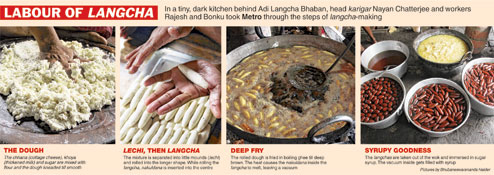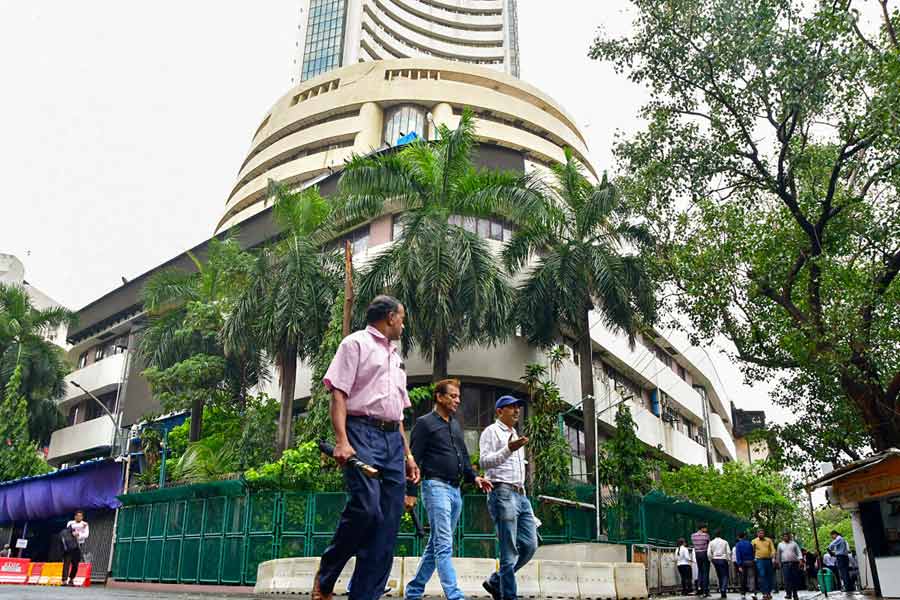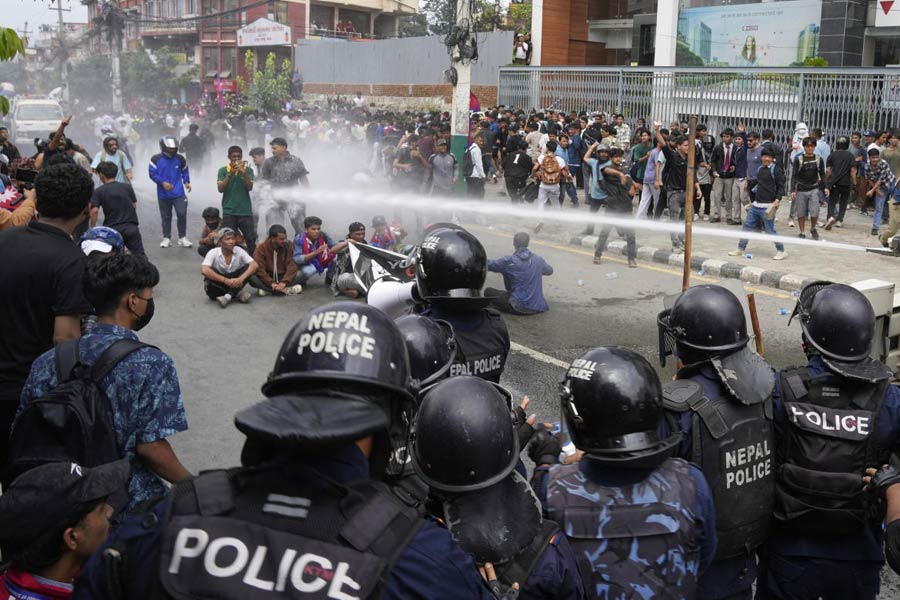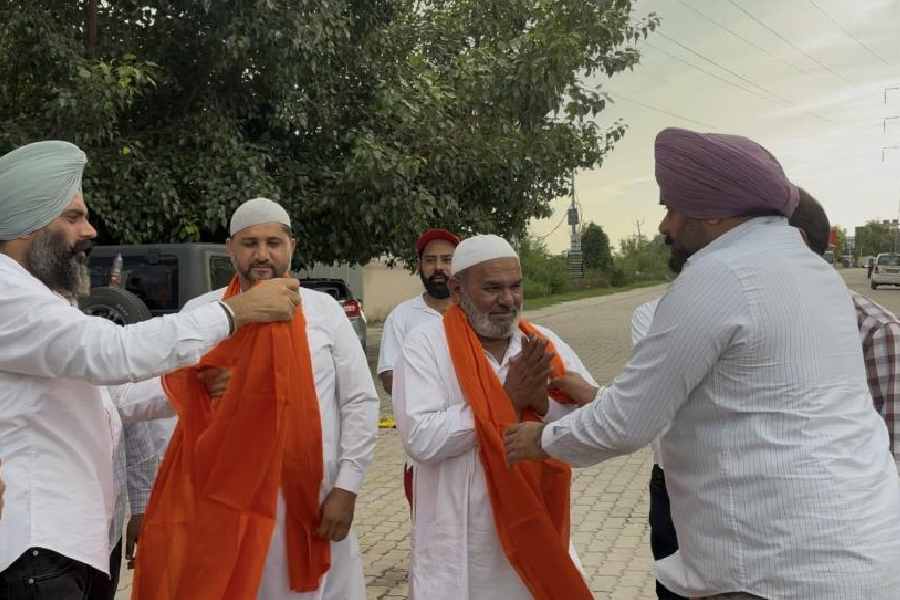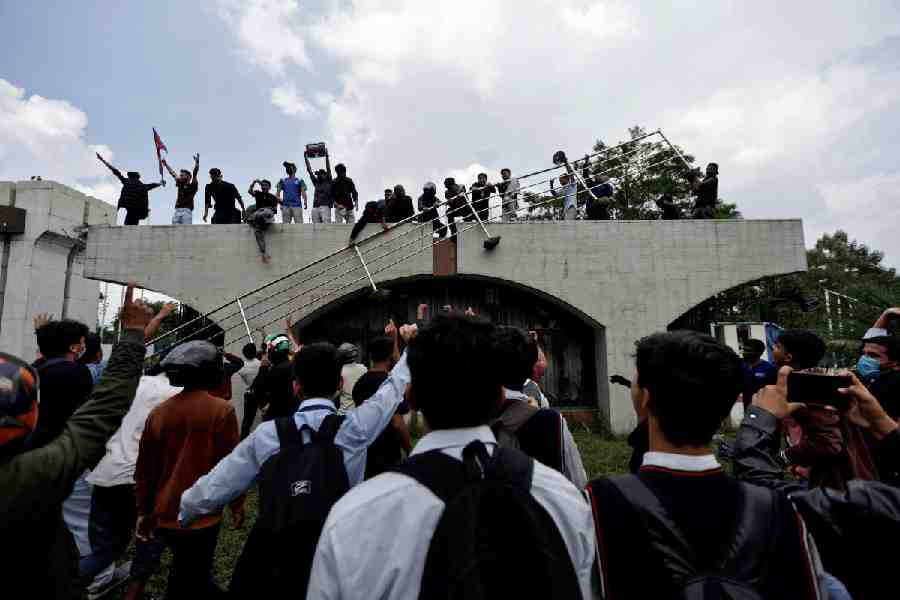 |
Samhita Chakraborty writes on the famed delicacy that makes Saktigarh a must-stop for Calcuttans on their way to Burdwan, Durgapur or Santiniketan
Langcha Bhaban, Langcha Bhuban, Langcha Niketan, Langcha Mahal… Dham, Home, Hall, House — this is langcha land and you just can’t miss it.
Saktigarh in Burdwan district, some 80km from Calcutta, is synonymous with the elongated fried syrupy sweet called langcha. And whether you love your langcha or lump it, if you are travelling down National Highway 2 — Delhi Road to most — Saktigarh is your stopover.
It was 43°C on Thursday afternoon, but Sudhendu Mondal, a professor of botany at Visva-Bharati, was digging into the langcha with single-minded focus. “Every time I travel between Santiniketan and Calcutta, I must stop at Saktigarh and have langcha,” smiled the former National Library director as he climbs into his car to head to Santiniketan.
The midway stop has been his routine for over 15 years.
A few metres down the road, on the other flank of the highway, Chaiti Sarkar also stopped. The engineering graduate from Suri in Birbhum was going back to her Behala home after completing her course. Her bus stopped in front of Balaji Food Park and she was finishing her meal of dahi-vada and ice-cream. She’s not so much into langcha, particularly in this heat.
But the idli-chowmein-samosa menu at the glass-fronted food park stocks — you guessed it — langcha too. This is langcha land, remember?
The langcha is said to have originated in Saktigarh, in the hands of a novice called Khudiram Dutta, who went on to establish Langcha Mahal. The sweet made Saktigarh famous, particularly after a crippled (langra or langcha in Bengali) British officer fell in love with it, or so goes the local lore. Today, the langcha has given the town quite a leg-up.
 |
That’s because, even though every shop grandly announces “Saktigarh’s traditional and authentic langcha”, the place where all cars, tin buses, swanky Volvos and trucks and lorries stop for a breather and a bite is not Saktigarh. It is Amra, a five-minute drive from Saktigarh.
Bidyut Ghosh, the proprietor of Adi Langcha Bhaban, explained: “My family has had a shop near the station for the past 50-60 years. But once the Delhi Road was built, it bypassed Saktigarh town and the number of customers fell sharply. So we set up shop here,” said the 45-year-old man, adding that former Bolpur MP Somnath Chatterjee was a regular at his highway shop. “Yes, the same man who might have become President,” he quipped.
Almost all the shops have framed photographs and autographs of famous patrons — Sourav Ganguly, Dev, Jisshu, June, Mamata Shankar, Mukul Roy and Ranjit Mallick, just to name a few langcha lovers. Most of the shops are open round the clock, their staff work in shifts to cater to daytime travellers and tourists and nightly stops by truck drivers.
The highway has come up in the past seven-eight years and has been fully functional in the last four. Such was the stream of travellers that Sadek Khan junked his potato trade and built himself a shop along the highway in 2009. He fondly calls it Adi Langcha Palace. The “palace” bit may require a generous stretch of the imagination but it does offer a royal treat to customers, something that many of its competitors don’t — clean toilets, that too separate ones for men and women.
Business is brisk even in peak summer and booming during winter. “On winter weekends, we sell as many as 15,000 langchas a day. It’s far lesser in summer, though,” said 21-year-old Sheikh Jamer, who has been working in a langcha shop for the past three years.
The most popular langcha is the Rs 5 lomba langcha. A smaller variety comes for Rs 3 and a super-size one for Rs 10. Then there’s the potol langcha, which is a “special” item with extra khoya (solidified milk).
The shops also sell Burdwan’s famed white Sitabhog and yellow mihidana.
Many stock monda (also called monda mithai), malpua, makha sandesh and milk cake as well.
Sweets apart, the shops dish out copious amounts of shingara, kochuri, tea, coffee, cold drinks and packaged chips.
At Adi Langcha Bhaban, longish packets of Oreo cookies share shelf space with the lomba langcha. Sadek has opened a fast-food stall just beside his sweet shop, selling packaged savouries and bottled drinks.
The langcha may be going strong, selling over 3,000 pieces in some shops even on lean days, but there are some murmurs of discontent.
Visva-Bharati professor Mondal insists that the Saktigarh langchas are not what they used to be. “The taste has changed over the years. While I had the most lovely langchas today, sometimes I have been served stale ones.”
The problem, according to Mondal, is that to cut costs, shopkeepers sometimes mix suji (semolina) with khoya and chhana (cottage cheese), which mars the taste.
A group of students from Durgapur also complained about the not-so-good langchas. “Initially, I would have the langcha during every trip home and back. Now the novelty has worn off. Not all the shops serve the best-quality langchas,” said Raunak, a Calcutta boy studying in Durgapur.
But for Durgapur resident Stuti, who was organising an Art of Living workshop in her city this weekend, a stop at Saktigarh was a must this Thursday. “I am travelling with an international teacher of Art of Living from Gujarat, Sailesh Raddadia. I just had to bring him here for a taste of the famed langcha,” smiled the pretty young lady.
So, what did her guest have to say about Saktigarh’s esteemed offering?
“Bahut badhiya!”
The art of living… in langcha land.

